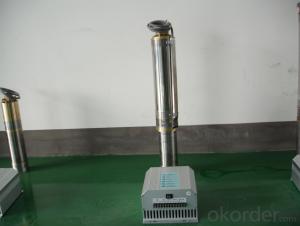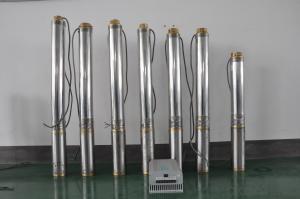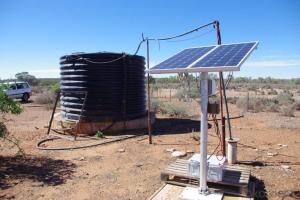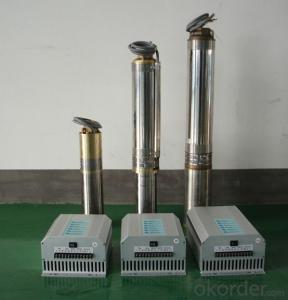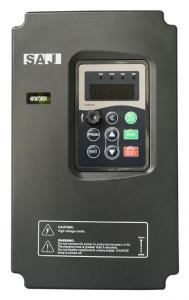DC Submersible Solar Pump
- Loading Port:
- China Main Port
- Payment Terms:
- TT OR LC
- Min Order Qty:
- -
- Supply Capability:
- -
OKorder Service Pledge
OKorder Financial Service
You Might Also Like
Item Description :
This superb new addition to our solar fountain range comes with a 10w solar panel,and a powerful fountain pump that is capable of producing fountains of up to 2m in height. As well as being easy to set up and use.Instruction manual is supplied for assembly and maintenance.
Solar Fountain Key Features :
Powered by direct sunlight
No high voltage electric mains required
Safe for children
Max. height of fountain: 2M
Max. flow capacity: 800 L/H(176 GAL)
10W Polycrystalline solar panel included
18V DC brushless pump
Solar Pump Features :
Can produce fountains up to : 2M (tube height) 1.4M (fountain height)
Comes with multiple nozzle accessories
Cable Length : 5M
Solar Panel Features :
10W peak power.
Polycrystalline highly efficient solar panel
Comes mounted in aluminium frame
Comes with ground stake and rotating knob so you can angle your panel toward the sun
What You Will Get :
10W solar panel
Solar pump
Ground Sake
Nozzle accessories
Precautions :
DO NOT alter or change the product itself or its components
Operate pump in freshwater only, never above 50 degrees celsius
Keep away from flammable liquids
Do not connect to any other power supply other than the included
- Q:How long does it take for a solar pump to pay for itself in terms of energy savings?
- The payback period for a solar pump in terms of energy savings depends on various factors such as the initial cost of the pump, the amount of energy savings achieved, and the local electricity rates. On average, it can take anywhere from 2 to 7 years for a solar pump to pay for itself through energy savings.
- Q:How long does it take for a solar pump to start pumping after installation?
- The time required for a solar pump to commence pumping after installation can vary due to several factors. Typically, it takes a few minutes to a couple of hours for the solar pump to initiate water pumping following installation. This is due to the necessity for the solar panels to accumulate adequate sunlight for generating sufficient energy to power the pump. Moreover, the time taken for the solar pump to commence pumping is also reliant on the location and prevailing weather conditions. In areas with abundant sunlight and clear skies, the pump may begin operating sooner if the solar panels are installed there. Conversely, if the weather is cloudy or there are obstructions hindering sunlight, it may take a longer period for the solar pump to initiate pumping. It is worth noting that the initial startup time may be slightly extended as the system requires establishing a connection and priming the pump. Once the solar panels have gathered sufficient energy and the pump is primed, it will commence pumping water continuously. In conclusion, the time it takes for a solar pump to start pumping after installation can vary from a few minutes to a couple of hours, contingent upon the availability of sunlight and the configuration of the system.
- Q:Can a solar pump be used for water supply in off-grid botanical parks?
- Indeed, water supply in off-grid botanical parks can be facilitated by the use of solar pumps. These pumps are specifically designed to operate by harnessing energy from the sun, making them an environmentally friendly choice for water supply. They have the ability to extract water from various sources such as wells or boreholes and transport it to the desired locations within the park, such as irrigation systems, ponds, or water features. The suitability of solar pumps for off-grid locations is particularly notable due to their independence from electricity grids and fossil fuels. Instead, they utilize photovoltaic panels to convert sunlight into electricity, which powers the pump. This inherent reliance on solar energy contributes to their reliability and cost-effectiveness, as they do not rely on external energy sources and require minimal maintenance. Moreover, solar pumps can be easily customized to meet the specific water demands of botanical parks. They are available in different sizes and capacities, allowing park managers to select the most appropriate pump for their needs. Additionally, solar pumps often come equipped with advanced features, such as automatic on/off switches, water level sensors, and variable speed drives, which ensure efficient and precise water distribution throughout the park. To summarize, solar pumps provide a viable and sustainable solution for water supply in off-grid botanical parks. They offer a multitude of advantages, including reduced energy costs, minimal environmental impact, and reliable operation, making them an excellent choice for fulfilling the water requirements of the park while reducing reliance on traditional energy sources.
- Q:Are there any limitations on the installation location or orientation of solar panels for a solar pump?
- Yes, there are certain limitations on the installation location and orientation of solar panels for a solar pump. The ideal location for solar panels is where they can receive maximum sunlight throughout the day, so they should be placed in an area with minimal shading. Additionally, the orientation of the solar panels should be towards the south (in the northern hemisphere) or towards the north (in the southern hemisphere) to optimize sun exposure. However, local regulations, building structures, and surrounding landscape can also impose restrictions on the installation location and orientation of solar panels for a solar pump.
- Q:Can a solar pump be integrated with existing water systems?
- Indeed, it is feasible to incorporate a solar pump into current water systems. Solar pumps are designed to be adaptable and can be effortlessly linked to existing water systems. The primary prerequisite is a solar energy source, typically in the form of solar panels, to supply power to the pump. Once the solar panels are connected to the pump, appropriate plumbing connections can be employed to integrate it into the existing water system. Consequently, the solar pump can extract water from the source and distribute it through the pre-existing pipelines, tanks, or irrigation systems. Although the integration process may vary depending on the specific configuration of the water system, it is absolutely possible to seamlessly integrate a solar pump into an existing water system with the appropriate expertise and equipment.
- Q:Are solar pumps suitable for both residential and commercial use?
- Yes, solar pumps are suitable for both residential and commercial use. They are an efficient and environmentally-friendly option for pumping water in various applications, including irrigation, livestock watering, and water supply for residential, commercial, and agricultural purposes. Solar pumps can be easily installed and operated, making them a versatile choice for both small-scale and large-scale water pumping needs.
- Q:What is the maximum head lift of a solar pump?
- The maximum head lift of a solar pump refers to the highest vertical distance that the pump can lift water from its source up to its destination. It depends on various factors such as the power output of the solar panels, the efficiency of the pump, and the local atmospheric conditions. Generally, solar pumps have a maximum head lift ranging from 30 to 200 meters, depending on the specific model and configuration.
- Q:How does the cost of maintenance for a solar pump system compare to a traditional electric pump?
- Compared to traditional electric pumps, solar pump systems generally have lower maintenance costs. This is because solar pump systems primarily rely on renewable energy, eliminating the need for electricity from the grid and reducing operating expenses. On the other hand, traditional electric pumps require a constant supply of electricity, which can be expensive, especially in areas with high electricity rates. In addition, solar pump systems have fewer moving parts, making them less susceptible to mechanical failures. This results in lower maintenance and repair expenses. Furthermore, solar pumps do not require fuel or lubrication, further reducing maintenance costs. Moreover, solar pump systems have longer lifespans than traditional electric pumps. While electric pumps typically last around 10-15 years, solar pumps can last up to 25 years or more when properly maintained. This prolonged lifespan reduces the need for frequent replacements and the associated costs. To summarize, the maintenance cost of a solar pump system is generally lower compared to that of a traditional electric pump. The reduced reliance on grid electricity, fewer moving parts, and longer lifespan all contribute to the overall cost-effectiveness of solar pump systems in terms of maintenance.
- Q:Can a solar pump be used for water supply in remote wildlife reserves?
- Yes, a solar pump can be used for water supply in remote wildlife reserves. Solar pumps are a sustainable and efficient solution that can provide a reliable water source without the need for electricity or fuel. They can be installed in remote locations and utilize solar energy to pump water, making them an ideal choice for wildlife reserves where access to electricity may be limited.
- Q:Can a solar pump be used for irrigation in greenhouses?
- Yes, a solar pump can be used for irrigation in greenhouses. Solar pumps are a sustainable and cost-effective solution for greenhouse irrigation as they utilize solar energy to power the pump, eliminating the need for electricity or fuel. This makes them suitable for remote locations or areas with limited access to electricity. Additionally, solar pumps can be easily integrated into existing irrigation systems, providing a reliable and environmentally friendly method to deliver water to greenhouse crops.
1. Manufacturer Overview |
|
|---|---|
| Location | |
| Year Established | |
| Annual Output Value | |
| Main Markets | |
| Company Certifications | |
2. Manufacturer Certificates |
|
|---|---|
| a) Certification Name | |
| Range | |
| Reference | |
| Validity Period | |
3. Manufacturer Capability |
|
|---|---|
| a)Trade Capacity | |
| Nearest Port | |
| Export Percentage | |
| No.of Employees in Trade Department | |
| Language Spoken: | |
| b)Factory Information | |
| Factory Size: | |
| No. of Production Lines | |
| Contract Manufacturing | |
| Product Price Range | |
Send your message to us
DC Submersible Solar Pump
- Loading Port:
- China Main Port
- Payment Terms:
- TT OR LC
- Min Order Qty:
- -
- Supply Capability:
- -
OKorder Service Pledge
OKorder Financial Service
Similar products
New products
Hot products
Related keywords
